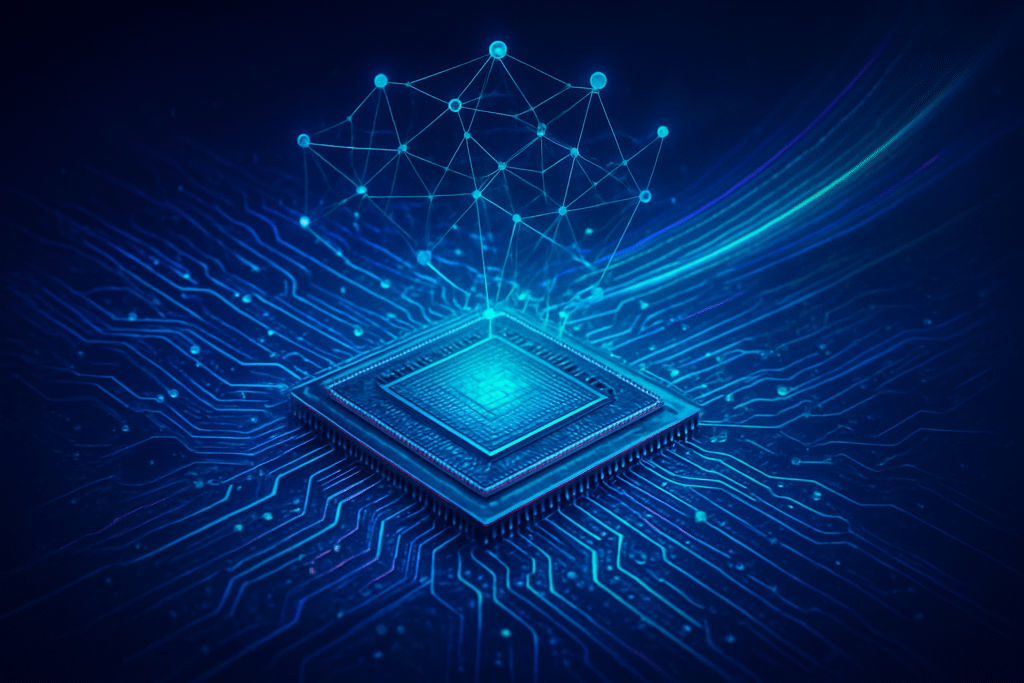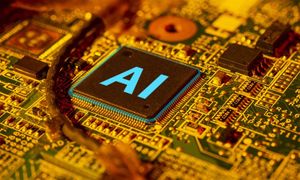
As of November 2025, the semiconductor market is experiencing a robust and unprecedented upswing, primarily propelled by the insatiable demand for Artificial Intelligence (AI) technologies. After a period of market volatility marked by shortages and subsequent inventory corrections, the industry is projected to see double-digit growth, with global revenue poised to reach between $697 billion and $800 billion in 2025. This renewed expansion is fundamentally driven by the explosion of AI applications, which are fueling demand for high-performance computing (HPC) components, advanced logic chips, and especially High-Bandwidth Memory (HBM), with HBM revenue alone expected to surge by up to 70% this year. The AI revolution's impact extends beyond data centers, increasingly permeating consumer electronics—with a significant PC refresh cycle anticipated due to AI features and Windows 10 end-of-life—as well as the automotive and industrial sectors.
This AI-driven momentum is not merely a conventional cyclical recovery but a profound structural shift, leading to a "silicon supercycle" that is reshaping market dynamics and investment strategies. While the overall market benefits, the upswing is notably fragmented, with a handful of leading companies specializing in AI-centric chips (like NVIDIA (NASDAQ: NVDA) and TSMC (NYSE: TSM)) experiencing explosive growth, contrasting with a slower recovery for other traditional segments. The immediate significance of this period lies in the unprecedented capital expenditure and R&D investments being poured into expanding manufacturing capacities for advanced nodes and packaging technologies, as companies race to meet AI's relentless processing and memory requirements. The prevailing industry sentiment suggests that the risk of underinvestment in AI infrastructure far outweighs that of overinvestment, underscoring AI's critical role as the singular, powerful driver of the semiconductor industry's trajectory into the latter half of the decade.
Technical Deep Dive: The Silicon Engine of AI's Ascent
Artificial intelligence is profoundly revolutionizing the semiconductor industry, driving unprecedented technical advancements across chip design, manufacturing, and new architectural paradigms, particularly as of November 2025. A significant innovation lies in the widespread adoption of AI-powered Electronic Design Automation (EDA) tools. Platforms such as Synopsys' DSO.ai and Cadence Cerebrus leverage machine learning algorithms, including reinforcement learning and evolutionary strategies, to automate and optimize traditionally complex and time-consuming design tasks. These tools can explore billions of possible transistor arrangements and routing topologies at speeds far beyond human capability, significantly reducing design cycles. For instance, Synopsys (NASDAQ: SNPS) reported that its DSO.ai system shortened the design optimization for a 5nm chip from six months to just six weeks, representing a 75% reduction in time-to-market. These AI-driven approaches not only accelerate schematic generation, layout optimization, and performance simulation but also improve power, performance, and area (PPA) metrics by 10-15% and reduce design iterations by up to 25%, crucial for navigating the complexities of advanced 3nm and 2nm process nodes and the transition to Gate-All-Around (GAA) transistors.
Beyond design, AI is a critical driver in semiconductor manufacturing and the development of specialized hardware. In fabrication, AI algorithms optimize production lines, predict equipment failures, and enhance yield rates through real-time process adjustments and defect detection. This machine learning-driven approach enables more efficient material usage, reduced downtime, and higher-performing chips, a significant departure from reactive maintenance and manual quality control. Concurrently, the demand for AI workloads is driving the development of specialized AI chips. This includes high-performance GPU, TPU, and AI accelerators optimized for parallel processing, with companies like NVIDIA (NASDAQ: NVDA) and AMD (NASDAQ: AMD) at the forefront. Innovations like neuromorphic chips, such as Intel's (NASDAQ: INTC) Loihi 2 and IBM's (NYSE: IBM) TrueNorth, mimic the human brain's structure for ultra-energy-efficient processing, offering up to 1000x improvements in energy efficiency for specific AI inference tasks. Furthermore, heterogeneous computing, 3D chip stacking (e.g., TSMC's (NYSE: TSM) CoWoS-L packaging, chiplets, multi-die GPUs), and silicon photonics are pushing boundaries in density, latency, and energy efficiency, supporting the integration of vast amounts of High-Bandwidth Memory (HBM), with top chips featuring over 250GB.
The initial reactions from the AI research community and industry experts are overwhelmingly optimistic, viewing AI as the "backbone of innovation" for the semiconductor sector. Semiconductor executives express high confidence for 2025, with 92% predicting industry revenue growth primarily propelled by AI demand. The AI chip market is projected to soar, expected to surpass $150 billion in 2025 and potentially reaching $400 billion by 2027, driven by the insatiable demand for AI-optimized hardware across cloud data centers, autonomous systems, AR/VR devices, and edge computing. Companies like AMD (NASDAQ: AMD) have reported record revenues, with their data center segment fueled by products like the Instinct MI350 Series GPUs, which have achieved a 38x improvement in AI and HPC training node energy efficiency. NVIDIA (NASDAQ: NVDA) is also significantly expanding global AI infrastructure, including plans with Samsung (KRX: 005930) to build new AI factories.
Despite the widespread enthusiasm, experts also highlight emerging challenges and strategic shifts. The "insatiable demand" for compute power is pushing the industry beyond incremental performance improvements towards fundamental architectural changes, increasing focus on power, thermal management, memory performance, and communication bandwidth. While AI-driven automation helps mitigate a looming talent shortage in chip design, the cost bottleneck for advanced AI models, though rapidly easing, remains a consideration. Companies like DEEPX are unveiling "Physical AI" visions for ultra-low-power edge AI semiconductors based on advanced nodes like Samsung's (KRX: 005930) 2nm process, signifying a move towards more specialized, real-world AI applications. The industry is actively shifting from traditional planar scaling to more complex heterogeneous and vertical scaling, encompassing 3D-ICs and 2.5D packaging solutions. This period represents a critical inflection point, promising to extend Moore's Law and unlock new frontiers in computing, even as some companies like Navitas Semiconductor (NASDAQ: NVTS) experience market pressures due to the demanding nature of execution and validation in the high-growth AI hardware sector.
Corporate Crossroads: Winners, Losers, and Market Maneuvers
The AI-driven semiconductor trends as of November 2025 are profoundly reshaping the technology landscape, impacting AI companies, tech giants, and startups alike. This transformation is characterized by an insatiable demand for high-performance, energy-efficient chips, leading to significant innovation in chip design, manufacturing, and deployment strategies.
AI companies, particularly those developing large language models and advanced AI applications, are heavily reliant on cutting-edge silicon for training and efficient deployment. Access to more powerful and energy-efficient AI chips directly enables AI companies to train larger, more complex models and deploy them more efficiently. NVIDIA's (NASDAQ: NVDA) B100 and Grace Hopper Superchip are widely used for training large language models (LLMs) due to their high performance and robust software support. However, while AI inference costs are falling, the overall infrastructure costs for advanced AI models remain prohibitively high, limiting widespread adoption. AI companies face soaring electricity costs, especially when using less energy-efficient domestic chips in regions like China due to export controls. NVIDIA's (NASDAQ: NVDA) CUDA and cuDNN software ecosystems remain a significant advantage, providing unmatched developer support.
Tech giants are at the forefront of the AI-driven semiconductor trend, making massive investments and driving innovation. Companies like Microsoft (NASDAQ: MSFT), Amazon (NASDAQ: AMZN), Google (NASDAQ: GOOGL), and Meta (NASDAQ: META) are spending hundreds of billions annually on AI infrastructure, including purchasing vast quantities of AI chips. To reduce dependency on external vendors like NVIDIA (NASDAQ: NVDA) and to optimize for their specific workloads and control costs, many tech giants are developing their own custom AI chips. Google (NASDAQ: GOOGL) continues to develop its Tensor Processing Units (TPUs), with the TPU v6e released in October 2024 and the Ironwood TPU v7 expected by the end of 2025. Amazon (NASDAQ: AMZN) Web Services (AWS) utilizes its Inferentia and Trainium chips for cloud services. Apple (NASDAQ: AAPL) employs its Neural Engine in M-series and A-series chips, with the M5 chip expected in Fall 2025, and is reportedly developing an AI-specific server chip, Baltra, with Broadcom (NASDAQ: AVGO) by 2026. Microsoft (NASDAQ: MSFT) and Meta (NASDAQ: META) are also investing in their own custom silicon, such as Azure Maia 100 and MTIA processors, respectively. These strategic moves intensify competition, as tech giants aim for vertical integration to control both software and hardware stacks.
The dynamic AI semiconductor market presents both immense opportunities and significant challenges for startups. Startups are carving out niches by developing specialized AI silicon for ultra-efficient edge AI (e.g., Hailo, Mythic) or unique architectures like wafer-scale engines (Cerebras Systems) and IPU-based systems (Graphcore). There's significant venture capital funding directed towards startups focused on specialized AI chips, novel architectural approaches (chiplets, photonics), and next-generation on-chip memory. Recent examples include ChipAgents (semiconductor design/verification) and RAAAM Memory Technologies (on-chip memory) securing Series A funding in November 2025. However, startups face high initial investment costs, increasing complexity of advanced node designs (3nm and beyond), a critical shortage of skilled talent, and the need for strategic agility to compete with established giants.
Broader Horizons: AI's Footprint on Society and Geopolitics
The current landscape of AI-driven semiconductor trends, as of November 2025, signifies a profound transformation across technology, economics, society, and geopolitics. This era is characterized by an unprecedented demand for specialized processing power, driving rapid innovation in chip design, manufacturing, and deployment, and embedding AI deeper into the fabric of modern life. The semiconductor industry is experiencing an "AI Supercycle," a self-reinforcing loop where AI's computational demands fuel chip innovation, which in turn enables more sophisticated AI applications. This includes the widespread adoption of specialized AI architectures like Neural Processing Units (NPUs), Tensor Processing Units (TPUs), and Application-Specific Integrated Circuits (ASICs), optimized for AI workloads, as well as advancements in 3nm and 2nm manufacturing nodes and advanced packaging techniques like 3D chip stacking.
These AI-driven semiconductor advancements are foundational to the rapid evolution of the broader AI landscape. They are indispensable for the training and inference of increasingly complex generative AI models and large language models (LLMs). By 2025, inference (applying trained AI models to new data) is projected to overtake AI training as the dominant AI workload, driving demand for specialized hardware optimized for real-time applications and autonomous agentic AI systems. This is paving the way for AI to be seamlessly integrated into every aspect of life, from smart cities and personalized health to autonomous systems and next-generation communication, with hardware once again being a strategic differentiator for AI capabilities. The growth of Edge AI signifies a trend towards distributed intelligence, spreading AI capabilities across networks and devices, complementing large-scale cloud AI.
The wider significance of these trends is multifaceted, impacting economies, technology, society, and geopolitics. Economically, the AI chip market is projected to reach $150 billion in 2025 and potentially $400 billion by 2027, with the entire semiconductor market expected to grow from $697 billion in 2025 to $1 trillion by 2030, largely driven by AI. However, the economic benefits are largely concentrated among a few key suppliers and distributors, raising concerns about market concentration. Technologically, AI is helping to extend the relevance of Moore's Law by optimizing chip design and manufacturing processes, pushing boundaries in density, latency, and energy efficiency, and accelerating R&D in new materials and processes. Societally, these advancements enable transformative applications in personalized medicine, climate modeling, and enhanced accessibility, but also raise concerns about job displacement and the widening of inequalities.
Geopolitically, semiconductors have become central to global economic and strategic competition, notably between the United States and China, leading to an intense "chip war." Control over advanced chip manufacturing is seen as a key determinant of geopolitical influence and technological independence. This has spurred a pivot towards supply chain resilience, with nations investing in domestic manufacturing (e.g., U.S. CHIPS Act, Europe's Chips Act) and exploring "friend-shoring" strategies. Taiwan, particularly TSMC (NYSE: TSM), remains a linchpin, producing about 90% of the world's most advanced semiconductors, making it a strategic focal point and raising concerns about global supply chain stability. The world risks splitting into separate tech stacks, which could slow innovation but also spark alternative breakthroughs, as nations increasingly invest in their own "Sovereign AI" infrastructure.
The Road Ahead: Charting AI's Semiconductor Future
In the immediate future (2025-2028), several key trends are defining AI-driven semiconductor advancements. The industry continues its shift to highly specialized AI chips and architectures, including NPUs, TPUs, and custom AI accelerators, now common in devices from smartphones to data centers. Hybrid architectures, intelligently combining various processors, are gaining traction. Edge AI is blurring the distinction between edge and cloud computing, enabling seamless offloading of AI tasks between local devices and remote servers for real-time, low-power processing in IoT sensors, autonomous vehicles, and wearable technology. A major focus remains on improving energy efficiency, with new chip designs maximizing "TOPS/watt" through specialized accelerators, advanced cooling technologies, and optimized data center designs. AI-driven tools are revolutionizing chip design and manufacturing, drastically compressing development cycles. Companies like NVIDIA (NASDAQ: NVDA) are on an accelerated product cadence, with new GPUs like the H200 and B100 in 2024, and the X100 in 2025, culminating in the Rubin Ultra superchip by 2027. AI-enabled PCs, integrating NPUs, are expected to see a significant market kick-off in 2025.
Looking further ahead (beyond 2028), the AI-driven semiconductor industry is poised for more profound shifts. Neuromorphic computing, designed to mimic the human brain's neural structure, is expected to redefine AI, excelling at pattern recognition with minimal power consumption. Experts predict neuromorphic systems could power 30% of edge AI devices by 2030 and reduce AI's global energy consumption by 20%. In-Memory Computing (IMC), performing computations directly within memory cells, is a promising approach to overcome the "von Neumann bottleneck," with Resistive Random-Access Memory (ReRAM) seen as a key enabler. In the long term, AI itself will play an increasingly critical role in designing the next generation of AI hardware, leading to self-optimizing manufacturing processes and new chip architectures with minimal human intervention. Advanced packaging techniques like 3D stacking and chiplet architectures will become commonplace, and the push for smaller process nodes (e.g., 3nm and beyond) will continue. While still nascent, quantum computing is beginning to influence the AI hardware landscape, creating new possibilities for AI.
AI-driven semiconductors will enable a vast array of applications across consumer electronics, automotive, industrial automation, healthcare, data centers, smart infrastructure, scientific research, finance, and telecommunications. However, significant challenges need to be overcome. Technical hurdles include heat dissipation and power consumption, the memory bottleneck, design complexity at nanometer scales, and the scalability of new architectures. Economic and geopolitical hurdles encompass the exorbitant costs of building modern semiconductor fabrication plants, supply chain vulnerabilities due to reliance on rare materials and geopolitical conflicts, and a critical shortage of skilled talent.
Experts are largely optimistic, predicting a sustained "AI Supercycle" and a global semiconductor market surpassing $1 trillion by 2030, potentially reaching $1.3 trillion with generative AI expansion. AI is seen as a catalyst for innovation, actively shaping its future capabilities. Diversification of AI hardware beyond traditional GPUs, with a pervasive integration of AI into daily life and a strong focus on energy efficiency, is expected. While NVIDIA (NASDAQ: NVDA) is predicted to dominate a significant portion of the AI IC market through 2028, market diversification is creating opportunities for other players in specialized architectures and edge AI segments. Some experts predict a short-term peak in global AI chip demand around 2028.
The AI Supercycle: A Concluding Assessment
The AI-driven semiconductor landscape, as of November 2025, is deeply entrenched in what is being termed an "AI Supercycle," where Artificial Intelligence acts as both a consumer and a co-creator of advanced chips. Key takeaways highlight a synergistic relationship that is dramatically accelerating innovation, enhancing efficiency, and increasing complexity across the entire semiconductor value chain. The market for AI chips alone is projected to soar, potentially reaching $400 billion by 2027, with AI's integration expected to contribute an additional $85-$95 billion annually to the semiconductor industry's earnings by 2025. The broader global semiconductor market is also experiencing robust growth, with forecasted sales of $697 billion in 2025 and $760.7 billion in 2026, largely propelled by the escalating demand for high-end logic process chips and High Bandwidth Memory (HBM) essential for AI accelerators. This includes a significant boom in generative AI chips, predicted to exceed $150 billion in sales for 2025. The sector is also benefiting from a vibrant investment climate, particularly in specialized AI chip segments and nascent companies focused on semiconductor design and verification.
This period marks a pivotal moment in AI history, with the current developments in AI-driven semiconductors being likened in significance to the invention of the transistor or the integrated circuit itself. This evolution is uniquely characterized by intelligence driving its own advancement, moving beyond a cloud-centric paradigm to a pervasive, on-device intelligence that is democratizing AI and deeply embedding it into the physical world. The long-term impact promises a future where computing is intrinsically more powerful, efficient, and intelligent, with AI seamlessly integrated across all layers of the hardware stack. This foundation will fuel breakthroughs in diverse fields such as personalized medicine, sophisticated climate modeling, autonomous systems, and next-generation communication. Technological advancements like heterogeneous computing, 3D chip stacking, and silicon photonics are pushing the boundaries of density, latency, and energy efficiency.
Looking ahead to the coming weeks and months, market watchers should closely track announcements from leading chip manufacturers such as NVIDIA (NASDAQ: NVDA) and AMD (NASDAQ: AMD), alongside Electronic Design Automation (EDA) companies, concerning new AI-powered design tools and further manufacturing optimizations. Particular attention should be paid to advancements in specialized AI accelerators, especially those tailored for edge computing, and continued investments in advanced packaging technologies. The industry faces ongoing challenges, including high initial investment costs, the increasing complexity of manufacturing at advanced nodes (like 3nm and beyond), a persistent shortage of skilled talent, and significant hurdles related to the energy consumption and heat dissipation of increasingly powerful AI chips. Furthermore, geopolitical dynamics and evolving policy frameworks concerning national semiconductor initiatives will continue to influence supply chains and market stability. Continued progress in emerging areas like neuromorphic computing and quantum computing is also anticipated, promising even more energy-efficient and capable AI hardware in the future.
This content is intended for informational purposes only and represents analysis of current AI developments.
TokenRing AI delivers enterprise-grade solutions for multi-agent AI workflow orchestration, AI-powered development tools, and seamless remote collaboration platforms.
For more information, visit https://www.tokenring.ai/.





